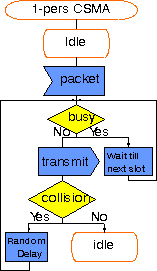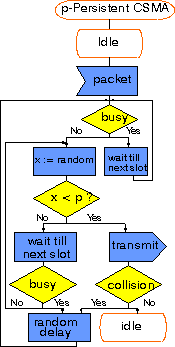
 |
JPL's Wireless Communication Reference WebsiteChapter: Data Networks
|
In CSMA, the delay is mainly caused by the time a mobile terminal takes to switch from reception to transmission mode (power-up), after sensing the radio channel for carriers from other active terminals.
The busy period is defined as the period during which the base station broadcasts a busy signal plus the preceding signalling delay d1. For memoryless Poisson arrivals, the duration of the idle period, i.e., the time interval starting at the release of the channel until the first packet arrival is exponentially distributed with mean I = 1/G.

The busy period is the time interval between the first arrival of a packet until the moment that the channel becomes idle. During the initial period d1 of the busy period the outbound channel thus still reports an idle inbound channel. The duration of the busy period is at least 1 + d2, but may be longer if a collision is caused by a packet arrival in during the inhibit delay. Moreover, persistent terminals, that sense a busy signal, may start to transmit immediately after the channel becomes idle. In such cases the busy period has a duration longer than two (or more) units of time.
Hence, the average duration of the busy period, B, depends on the signalling delay d1 and d2, and on the persistency p in (re-) scheduling inhibited packets.


Alternatively, the test packet itself starts during a period of duration d1 when the channel is busy because of a transmission by another terminal, but seems idle since the inhibit signal is not yet being broadcast. This event occurs with probability d1/(B+I). The test packet thus experiences interference from the packet that initiated the busy period, but possibly also from other arriving packets. The additional contending signals occur with a Poisson arrival rate during the interval d1.
Taking account of the above three possible events, the unconditional probability of successful transmission can be derived.
The above derivation differs from techniques typically used for wireline LANs, because in radio systems we mostly want to be able to consider expressions for capture probabilities, depending on the location of one particular terminal.